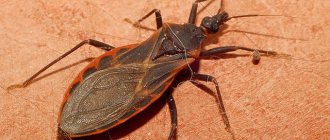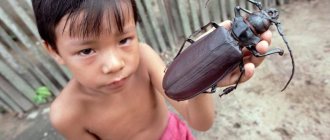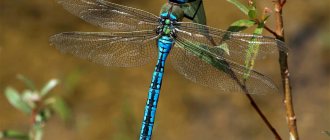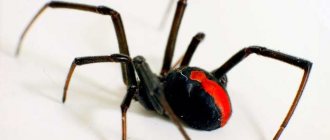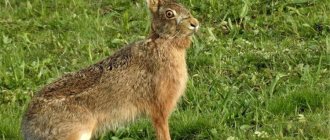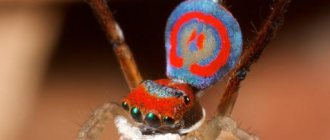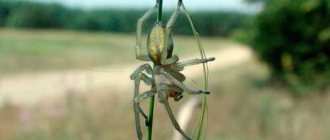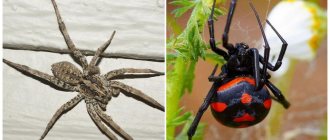Many people are afraid of spiders. But fear of them is not always just a phobia. Despite the fact that the northern Russian climate does not create ideal conditions for the life of insects and arachnids, the southern territories have everything necessary for their life and development.
There are spiders throughout the country that should be avoided and feared, as they can cause significant harm to human health. And even more than that, certain species can threaten life. It is worth considering the 5 most dangerous arachnids in order to remember them once and for all.
Fifth place - phalanx
Spider - phalanx
A spider called phalanx is also called salpuga. It does not have its own poison, but this does not make it safe. This creature willingly attacks people, and its bite is dangerous because there are a lot of microorganisms on its mandibles. If there is a bite that feels quite painful, it is necessary to squeeze the blood out of the wound in order to wash it in this way and reduce the risk of infection. This spider is active at night; the chances of getting bitten during the day are negligible. Lives in the southern regions of the country.
Features of behavior
Salpugs are aggressive creatures. They attack absolutely everyone they can handle. Their victims often include insects, spiders, caterpillars, as well as rodents, birds, lizards, and snakes. The phalanxes fearlessly rush into battle with the scorpion and often win.
Salpugs wait for the victim in a secluded place, and when they see it, they take a frightening position - they raise their chests and extend their tentacles forward.
Phalanxes run at a speed of 16 km per hour, so it is very difficult to escape from such a predator. If necessary, the salpuga long jumps at a distance of up to 1 m.
Extremely voracious fertilized females. If he manages to defeat the rodent, he eats everything in one go. With its powerful jaws it tears apart the shell and gnaws out the insides. The murder weapon is claws, tentacles, and powerful jaws. The spider does not inject venom and does not paralyze the victim.
The main diet is insects, beetles, spiders. Larger species attack chicks, rodents, lizards, frogs, toads, and scorpions. Salpugs have practically no natural enemies. The power of the chelicerae allows you to easily cut off feathers, fur, cut through skin, shell, and crush thin bones.
When attacked, the phalanx emit an unpleasant piercing squeak and chirping sound.
Camel spider (salpuga, phalanx spider)
Fourth place - bag spider
Bag spider
The bag spider, or bagworm, is also a southern resident who chose the Rostov and Volgograd steppes as its habitat. Its bite causes very severe pain, which does not go away for a day or more, but the attack of this creature does not create serious harm to health.
Interesting: Karakurt or black widow - description, habitat, nutrition, reproduction, enemies, photos and videos
26.08.2016
In the morning, a large Mediterranean turtle was found on the camp grounds: it was crossing the clearing with its usual leisurely step. A wildcat and a wild boar with piglets were scared away near the pond.
For lunch, we planned an excursion to an experimental fish hatchery where Russian sturgeon, beluga and trout are raised. Upon reaching a certain size, the fry are released into the sea to replenish the population of rare fish in nature.
On the way back we decided to visit the oldest city in Russia - Derbent. I fell asleep in the car, and when I woke up, I couldn’t figure out what country I was in. The car drives along narrow winding streets that rush upward towards the fortress; the city architecture resembles Iran, and the people speak a different language - that’s the impression Derbent, a piece of the eastern world on Russian territory, made on me.
The Mediterranean turtle (Testudo graeca pallasi) is listed in various Red Books as a species with a sharply declining population. A separate subspecies lives on the territory of the Dagestan Nature Reserve, some of its representatives reach an impressive size of 30 cm, their weight can exceed 3 kg. Photo: Ilya Gomyranov/Schrodinger's Cat
Second place - Mizgir
Mizgir spider
Mizgir is a southern Russian tarantula, which is distinguished by its large size and love for a nocturnal lifestyle. Its bite is not capable of killing a person, but it still injects poison. The pain will continue for a long time after the bite, and in addition, severe swelling may appear. An allergic reaction often occurs to injected substances, which also hides danger. But more serious side effects are rare.
Is it possible to keep at home?
Fans of arachnids can keep salpuga in a home terrarium. At the same time, we must remember about its ability to move along vertical surfaces, including glass, and jump up to 1 meter in height. The terrarium must be airtight. It is necessary to create shelters for the animal during the daytime. Depending on the type of salpuga, it can be sand, stones mixed with earth.
Arthropods love to bask in the rays of an ultraviolet lamp. The construction of such a heat source will make the salmon’s stay in the terrarium more comfortable.
Live food is introduced into the terrarium when the phalanx is in the burrow. The predator's diet should include large insects and woodlice. The phalanx is fed 2-3 times a week, avoiding overfeeding, which can cause it to die.
https://youtube.com/watch?v=TXHdPpiVjcQ
The most dangerous spider in Russia
Karakurt
And in first place, with a large gap from all other contenders, is karakurt. If you translate this word from the Turkic language, you get a black insect. But this is not a worm at all, and in addition to its black color, it has red spots. The coloring of karakurts is remarkable; it immediately attracts attention and should cause concern. Red spots on the black back are visible from afar. In fact, only the females of this species are poisonous, and the males do not pose a serious danger. And females are also easy to distinguish - they have a red pattern on their abdomen that resembles an hourglass . Read more about this pack in our article: Karakurt spider.
This spider differs from all others in that it has a truly dangerous poison that can bring not only discomfort, but also death. While less poisonous spiders only bring pain and discomfort with their bite, this one is capable of killing a horse with its venom. After a bite, severe pain is felt throughout the body, and in order to save the person, it is necessary to urgently take him to the hospital and provide a special serum. Only after this will the patient have a chance of survival, although the unpleasant consequences and symptoms will continue for some time. The habitat of the karakurt is the south, these spiders live in the Crimea and nearby regions, they live mainly in the steppes.
Interesting: The fastest animals - list, speed, names, where they live, photos and videos
There are other spiders in Russia, encountering which does not bode well, but they all only cause pain and discomfort. However, an allergic reaction can also occur to bites, and therefore, if this happens, it is necessary to carefully treat the bitten person and immediately take him to the hospital if the condition begins to worsen.
Anaphylactic shock when exposed to insects and spiders is not uncommon. However, most of the spiders to be wary of are southern creatures, and for the time being this was pleasing. But in recent years, the situation has changed dramatically, and scientists have recorded that the range of spiders, including dangerous ones, is extending further and further to the north. This is associated with climate warming.
Despite the fact that the same phalanx is sometimes encountered in the Moscow region, there is no need to panic. Many scientists believe that this is a temporary phenomenon, and in the future the situation will stabilize, worsening only in particularly hot seasons.
But be that as it may, it’s worth knowing dangerous spiders by sight in order to protect yourself and to protect your loved ones, especially children. After all, a large spider always attracts attention, and increased interest in its person may well provoke an attack. Even though most spiders are nocturnal, you should take the risk of encountering them seriously.
Habitat and lifestyle
Tarantulas are typical inhabitants of deserts, semi-deserts and arid steppe regions of Eurasia, Central and South America, North Africa, and Australia.
Apulian tarantula (Lycosa tarantula).
These nocturnal predators during the day prefer to hole up in burrows up to 60 cm deep, camouflaged by fallen leaves. Tarantulas do not build trapping nets, but use cobwebs to frame the walls of the burrow, and females weave a cocoon from threads to bear offspring.
Tarantula hole, steppe of Kherson region.
With the onset of darkness, tarantulas go out hunting, lying in wait for prey right in their hiding place or wandering around the surrounding area. The tarantula's hunting method is characteristic of most wolf spiders: the predator attacks its prey, paralyzing or killing it with its poison, and then sucks out the contents.
Tarantula hunting without leaving its hole. Uzbekistan - 04/05/2008.
The basis of the diet of tarantulas consists mainly of insects and their larvae: flies, cockroaches, crickets, beetles, as well as smaller representatives of their own order. Enlarged photos of tarantulas eating their prey are quite impressive.
Meadow moth in the arms of the South Russian tarantula.
30.08.2016
We are sitting at the station in Makhachkala, waiting for the train, surrounded by the unusual bustle of the city. Then again a couple of days of travel and Moscow. Meeting with family, endless tasks and concerns: every trip leaves many impressions, emotions and shots in the camera.
Ilya Gomyranov is a biologist and wildlife photographer. Winner, laureate and finalist of photo competitions “Golden Turtle”, The Best of Russia, “The Art of Science”. Participant of more than 20 expeditions - visited the tundra and subtropics, the Middle and Far East, Africa and the New World.
28.08.2016
In the morning, a viper was found in one of the old, abandoned buildings - another dream came true. Under the supervision of my colleagues, I photograph a dangerous snake. At other moments, there are only a few centimeters left before it, then they pull me back: safety comes first. Just recently, a shepherd died from a snake bite. At the end of the photo session, please take the snake away from the cordon so that it does not bite children.
After lunch we go to the barn to photograph lesser horseshoe bats - these are rare bats, a colony of which has settled very close to the cordon. During the day they sleep in a cool basement, and at night they fly in search of food.
It was a very beautiful sunset. All the previous ones were quite monotonous: the sun simply disappeared behind the horizon.
A small colony of lesser horseshoe bats (Rhinolophus hipposideros) settled in an abandoned barn near the reserve's border. These are very unusual bats, living in colonies of 10–50 individuals. Giant ears and a special leaf-shaped outgrowth near the nose help them with echolocation, which is necessary for hunting in complete darkness. Photo: Ilya Gomyranov/Schrodinger's Cat
Secretive six-eyed
The central regions of South America and the deserts of Africa are home to a small (body up to 1.5 cm, legs about 5 cm) killer six-eyed sand spider. Outwardly, it resembles a crab, the color is yellow or brown in different shades, allowing it to blend in with the surrounding soil. That is why it is also called sand spider or crab spider. Its characteristic feature is the presence of three pairs of eyes instead of the traditional four. It can live up to 15 years; in other species this value does not exceed 3.
Six-eyed spiders almost never weave webs. Exceptions are the cocoon sacs in which the female lays her eggs. These spiders hunt by waiting for prey in ambush. They are generally secretive and prefer to avoid people. Therefore, although they are very poisonous, only 2 of their victims have been recorded. The deadly substance injected by the spider destroys the blood vessels, and the person slowly dies from internal bleeding. Unfortunately, there is no antidote yet.
